SECTION 13-F 1957 BUICK CONVERTIBLE TOP (ALL SERIES)
13-16 INTRODUCTION (ALL SERIES CONVERTIBLES)
The following new features have been incorporated into the 1957 Buick convertible folding tops: Two locking handles are used to secure the front roof rail to the windshield header.
“Floating” trim sticks designed to pivot with the movement of the top as it is lowered or raised, are used to secure the top fabric at the rear quarter areas. The rear end of the trim stick is attached to a support which in turn is secured to the rear quarter inner panel, while the forward end of the trim stick is positioned in a guide.
A newly designed folding top male hinge secures the linkage to the body at the rear quarter area on Series 40-60 convertibles only.
The removal and installation of the folding top trim assembly and weatherstrips are similar to the procedure used on past convertibles. On series 40-60 convertibles only, the adjustment of the top linkage is partially new due to the new design of the folding top male hinge.
13-17 SIDE ROOF RAIL WEATHERSTRIPS (ALL SERIES CONVERTIBLES)
The sealing along each folding top side roof rail is accomplished by a front, center and rear section of weatherstrip. These weatherstrips are attached to the side roof rails with nuts on the integral studs of the weatherstrip section. In addition, the ends of the weatherstrip sections are secured to the side roof rail with screws.
The procedure below outlines the removal and installation of all three (3) sections of weatherstrip. Each section may be removed and installed separately if desired.
Removal of Side Roof Rail Weatherstrips
- Lower 1957 Buick convertible top halfway.
- Remove weatherstrip attaching screws at ends of each section of weatherstrip.
- Remove screw securing end of front roof rail weatherstrip retainer. Then with a flat bladed tool, carefully break cement bond between front roof rail rear weatherstrip and side roof rail front weatherstrip.
- Remove weatherstrip attaching nuts and washers and remove weatherstrips.
Installation of Side Roof Rail Weatherstrips
- Clean off cement from front and side roof rails to insure clean cementing surfaces.
- Apply an approved weatherstrip cement to forward portion of side roof rail front weatherstrip and to end of front roof rail rear weatherstrip. Then install side roof rail weatherstrip to form “butt” joint with front roof rail weatherstrip.
- Apply a ribbon of body caulking compound along entire length of attaching surface on each side roof rail weatherstrip section just outboard of the integral studs and reverse removal procedure. (See figure 13-100.)

1957 Buick Side Roof Rail Weatherstrip View
Clean off excess cement and sealer.
Adjustment of Side Roof Rail Weatherstrips
- The side roof rail weatherstrip sections may be adjusted inboard or outboard. To adjust, remove attaching screws, loosen attaching nuts and position as desired. Tighten nuts and reinstall attaching screws. If necessary, drill new hole for weatherstrip front attaching screw.
- The side roof rail weatherstrips may also be adjusted downward. To perform this adjustment, loosen weatherstrip as required and insert waterproof cardboard shim between weatherstrip and side roof rail, tighten weatherstrip attaching nuts and reinstall attaching screws.
13-18 FRONT ROOF RAIL WEATHERSTRIP$ (ALL SERIES CONVERTIBLES)
Two weatherstrips of different types are used along the front roof rail. The front weatherstrip is a trim covered 1/2″ diameter round rubber which is tacked to the front roof rail trim stick. The rear weatherstrip is a door weatherstrip-type section and is secured to the front roof rail by weatherstrip cement and by the rear edge of a two piece metal retainer.
To remove either weatherstrip, lower the 1957 Buick Convertible top and remove the two piece metal retainer; then remove tacks securing front weatherstrip or break cement bond securing rear weatherstrip. To install weatherstrip, reverse removal procedure. When installing rear weatherstrip, follow cementing instructions outlined for the door weatherstrip.
13-19 1957 BUICK CONVERTIBLE TOP ADJUSTMENTS (ALL SERIES CONVERTIBLES)
The 1957 Buick Convertible top linkage consists of three sections of right and left side roof rails and a front roof rail connected together by bolts, hinges, and a series of connecting links and bows. The top linkage is attached to the body at the rear quarter area by a male hinge bolted – to an adjustable support. The front roof rail is locked at the windshield header by two cam locks which are an integral part of the two locking handles.
The following information outlines and illustrates procedures which may be used to correct misaligned folding top linkage. To correct some top variations, only a single adjustment is required; other top variations require a combination of adjustments. In conjunction with adjustment of the folding top, it may be necessary to adjust the door, door glass, rear quarter glass, or the side roof rail weatherstrips. After any adjustments are made, the folding top should be checked at the rear quarter area for proper fit. In some cases, the folding top rear quarter trim stick front outer guide and the trim stick and support assembly may be adjusted slightly to obtain proper fit of top material at the rear quarter area.
Adjustment of 1957 Buick Convertible Top at Front Roof Rail Corner Brace
If the 1957 Buick Convertible top when in a raised position is too far forward or does not move forward enough to allow the guide studs on the front roof rail to enter the holes in the striker assembles, proceed as follows:
- Unlatch top and raise it above windshield header. Remove side roof rail weatherstrip front attaching screw.
- Loosen corner brace attaching bolts indicated in figure 13-101 and adjust front roof rail fore or aft as required.
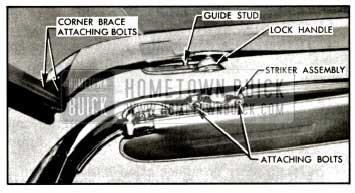
1957 Buick Front Roof Rail Corner Brace
Repeat on opposite side if necessary. NOTE: This adjustment is limited. If additional adjustment is required, it can be made at the folding top male hinge.
Adjustment of 1957 Buick Convertible Top at Lock Handle Striker and Front Roof Rail Guides
If a difficult locking action, caused by misalignment of the front roof rail lock handle strikers is encountered at the front roof rail, or if a closer fit of the front roof rail to the windshield header is desired, proceed as follows:
- Unlatch top and raise it above windshield header.
- Loosen striker attaching screws and adjust striker up or down or from side to side as required. If necessary, also loosen front roof rail guide attaching screws and adjust guide as required.
- If an additional upward adjustment of the front roof rail is desired, remove handle and install emergency washer into lock spindle cavity in handle, then install handle with emergency attaching screw.
Adjustment of Rear Quarter Trim Stick and Support Assembly
In some cases, the rear quarter trim stick and support assembly may be adjusted slightly to remove wrinkles of the top material at the rear quarter area. To adjust the trim stick and support proceed as follows:
- Remove screws securing 1957 Buick Convertible top compartment bag to seat back panel.
- Loosen support attaching bolts and outer guide attaching screws and adjust trim stick as required to obtain proper fit of 1957 Buick Convertible top material; then tighten support attaching bolts.
- Lock front roof rail to windshield header; then position trim stick outer guide to contact top of inner guide and tighten outer guide attaching screws.
- Install compartment bag attaching screws.
Adjustment of Top at Control Link Adjusting Plate (Series 40-60)
- If there is a sag in the joint between the front and center side roof rail, proceed as follows:
- Remove folding top compartment side trim panel and loosen front bolt securing control link adjusting plate indicated in figure 13-102.
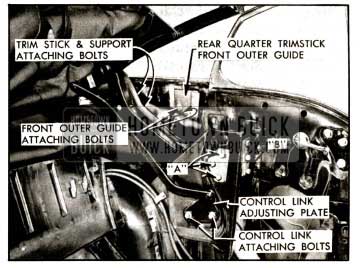
1957 Buick Convertible Top Adjustments-Series 40-60
- Skip over serrations on support and pivot front portion of plate downward as required; then tighten bolt.
- If the 1957 Buick Convertible top linkage does not stack properly, proceed as follows:
Loosen rear bolt securing control link adjusting plate; then pivot rear portion of adjusting plate over serrations as required to obtain desired stack height; then tighten bolt.
Adjustment of Top at Control Link Adjusting Plate (Series 50-70)
- If there is a sag in the joint between front and center side roof rail, proceed as follows:
- Remove folding top compartment side trim panel and loosen two (2) bolts securing control link adjusting plate indicated in figure 13-103 sufficiently to permit adjustment of the plate.
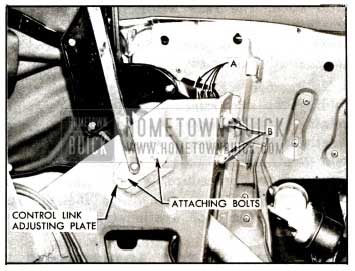
1957 Buick Folding Top Adjustments-Series 50-70
- Without any change in fore and aft location of adjusting plate, skip over serrations on support and move plate downward as required; then tighten bolt.
- If the top linkage does not stack properly, proceed as follows:
- Loosen bolts securing control link adjusting plate sufficiently to permit adjustment of the plate.
- Without any change in the “up” or “down” location of the adjusting plate, move adjusting plate forward or rearward (horizontally) over serrations as required to obtain desired stack height. Then tighten bolts.
Adjustment of 1957 Buick Convertible Top at Male Hinge Support (Series 40-60)
The male hinge is entirely new in design and method of attachment, thereby requiring new service procedures. The male hinge is secured to the support by three bolts at the front of the support and by three bolts at the side of the support. Prior to making an adjustment to raise the top linkage at the male hinge, loosen the two bolts securing the folding top rear quarter trim stick front outer guide to the rear quarter panel. This will prevent any possible damage to the top when it is raised after adjustment. After making an adjustment at the male hinge, check the folding top at the rear quarter area for proper fit and where necessary adjust the guide and the trim stick and support assembly.
- If there is an excessive opening between the side roof rail rear weatherstrip and the rear quarter window, or if the front roof rail is too far forward or rearward, proceed as follows:
- Loosen three male hinge attaching bolts. “A” figure 13-103.
- Move hinge fore or aft, as required, then tighten bolts.
- Lock front roof rail to windshield header, and check side roof rail alignment and readjust if necessary.
- Lock front roof rail to windshield header and check fit of 1957 Buick Convertible top material at rear quarter trim stick area and, if necessary, adjust trim stick. See “Adjustments of Rear Quarter Trim Stick and Support Assembly”. If adjustment is not necessary, tighten outer guide attaching screws.
- If the side roof rail is too high or too low at the rear quarter window area, proceed as follows:
- Loosen bolts securing rear quarter trim stick front outer guide.
- Loosen attaching bolts “B” figure 13-103. In addition to bolts, support is secured firmly in place by serrations on contacting surfaces of support and brace.
- Adjust support up or down as required, then tighten bolts.
- Lock front roof rail to windshield header, and check side roof rail alignment. Readjust if necessary.
- Check fit of top material at rear quarter trim stick area and, if necessary, adjust trim stick front guide. See “Adjustment of Rear Quarter Trim Stick and Support Assembly”.
Adjustment of 1957 Buick Convertible Top at Male Hinge Support (Series 50-70)
The adjustments at the male hinge support are similar to those on previous styles. Prior to making an adjustment to raise the top linkage at the male hinge, loosen the two bolts securing the folding top rear quarter trim front outer guide to the rear quarter panel. This will prevent any possible damage to the top when it is raised after adjustment. After making an adjustment at the male hinge, check the folding top at the rear quarter area for proper fit and where necessary adjust the guide and the trim stick and support assembly.
- If there is an excessive opening between the side roof rail rear weatherstrip and the rear quarter window, or if the front roof rail is too far forward or rearward, proceed as follows:
- Loosen four male hinge attaching bolts. “A”. See figure 13-103.
- Move hinge fore or aft, as required, then tighten bolts.
- Lock front roof rail to windshield header and check side roof rail alignment, and readjust, if necessary.
- Lock front roof rail to windshield header and check fit of top material at rear quarter trim stick area and if necessary, adjust trim stick. See “Adjustments of Rear Quarter Trim Stick and Support Assembly”. If adjustment is not necessary, tighten outer guide attaching screws.
- If the side roof rail is too high or too low at the rear quarter window area, proceed as follows:
- Loosen bolts securing rear quarter trim stick front outer guide.
- Loosen attaching bolts “B”. In addition to bolts, support is secured firmly in place by serrations on contacting surfaces of support and brace.
- Adjust support up or down as required, then tighten bolts.
- Lock front roof rail to windshield header and check side roof rail alignment and readjust if necessary.
- Check fit of top material at rear quarter trim stick area and, if necessary, adjust trim stick front guide. See “Adjustment of Rear Quarter Trim Stick and Support Assembly”. If adjustment is not necessary, tighten outer guide attaching screws.
13-20 1957 BUICK CONVERTIBLE TOP TRIM ASSEMBLY (ALL SERIES CONVERTIBLES)
The 1957 Buick Convertible top trim on the 1957 convertibles is attached in a manner similar to that used on past models except for the “floating” trim stick at each rear quarter. Due to the new trim stick design, the removal and installation procedure of the top trim in the quarter area is slightly different from the procedure used on past models.
Removal of 1957 Buick Convertible Top Trim Assembly
- Place protective covers on all exposed panels which may be contacted during procedure.
- Remove following trim and hardware items:
- Rear seat cushion and back.
- Folding top compartment side trim (arm rests).
- Side roof rail wear weatherstrip; then loosen top flaps from rail.
- At the front of body, raise front roof rail, remove retainers and front weatherstrip and detach top material from front roof rail.
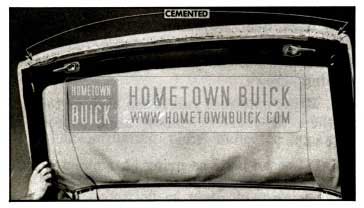
1957 Buick Trim Attachment at Front Roof Rail
- Detach folding top compartment bag from rear seat back panel and attach it to rear roof bow, thus exposing rear trim stick attaching screws and rear quarter trim stick assemblies.
- At each rear quarter area remove two bolts and washers securing rear quarter .trim and support assembly to rear quarter inner panel.
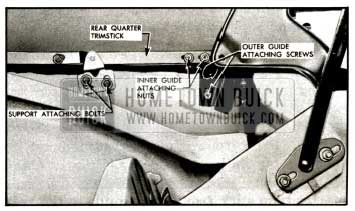
1957 Buick Rear Quarter Trim Stick and Support Assembly
- Remove rear trim stick attaching screws; then lift trim assembly with attached quarter and rear trim sticks on top of rear compartment front panel. Remove nuts and washer securing front inner guide to trim sticks and remove inner guide.
- Remove screw securing escutcheon clip at each end of wire-on-binding on rear bow. Then remove wire-on-binding from rear bow and detach top material, side stay pads, back curtain and quarter stay pads from trim sticks and rear bow; then carefully lower rear bow. The trim sticks, with attached compartment bag, can be removed from body and placed on clean bench.
- Loosen front end of side roof rail front weatherstrip sufficiently to detach top material flap which is cemented to rail.
- Remove side stay pads attached to front roof rail with tacks and to front and center bows with screws; then, lock front roof rail to windshield header.
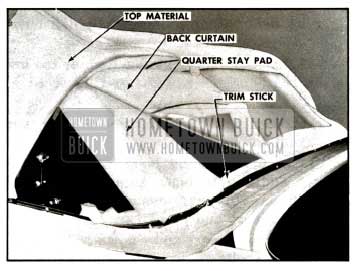
1957 Buick Folding Top Components at Rear Window Area
Installation of 1957 Buick Convertible Top Trim Assembly
- Position rear bow for proper installation by installing spacer sticks as shown in figure 13-107.
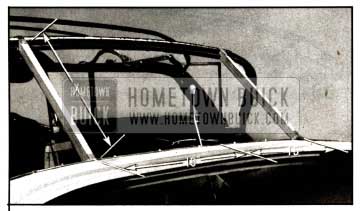
1957 Buick Rear Bow Positioning
Note that sticks are placed 30 inches apart, each being 15 inches from the centerline of body. The stick length “X” is approximately 18 1/2 inches for Buick “40” and “60” Series Convertibles or 21 inches for Buick “50” and “70” Series Convertibles, measured from chrome belt molding to rear rolled edge on tacking strip.
- As a bench operation, tack rear quarter stay pads to large trim stick, as shown in figure 13-108.
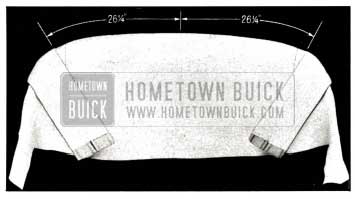
1957 Buick Tacking Rear Quarter Stay Pads
Note that inner edges of pads are 26 1/4, inches from center of trim stick. Lower edges of pads are set flush with lower edge of trim stick for positive location.
- Next, center and tack back curtain to trim stick as shown in figure 13-109.

1957 Buick Tacking Back Curtain
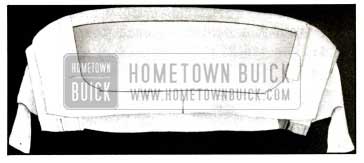
1957 Buick Back Curtain Assembly
The shorter lower edge of curtain should be set flush with lower edge of trim stick as shown in figure 13-109. Tack curtain to a point opposite outer edges of window and leave outer ends of curtain loose. Tacks should be placed close to each side of every screw hole in trim stick. Then pierce back curtain for each screw.
- Inspect rubber trim stick fillers cemented to body below pinchweld as shown in figure 13-111.
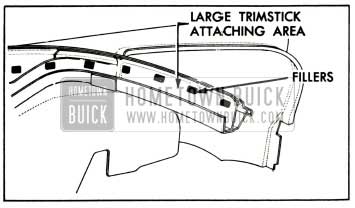
1957 Buick Trim Stick Fillers
Recement if necessary.
- Next, install center trim stick, with pads and curtain attached, in body. Secure back curtain with one tack in rear bow to prevent damage to plastic sheet. Attach the trim stick with screws at each end, at the sharp bends and at center. Make sure that each screw is driven completely in to represent finished conditions.
- Tack quarter stay pads to rear bow with inner edges located at the offset in rear bow as shown in figure 13-112.

1957 Buick Pad and Curtain Attachment to Large Bow
Trim off excess material at rear bow.
- Install side stay pads in the conventional manner. Dimension “Y” in figure 13-113 is approximately 17 3/8 inches for Buick “40” and “60” Series convertibles or 18 inches for Buick “50” and “70” Series convertibles and is measured from the center of each bow at inner edge of the pad.
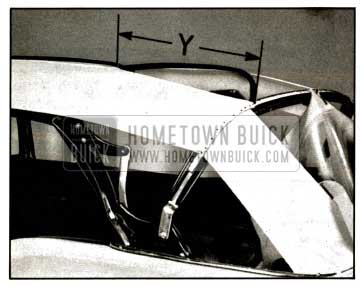
1957 Buick Positioning of Bows
- Remove spacer sticks when side pads have been installed.
- Tack back curtain to rear bow as shown in figure 13-114.

1957 Buick Tacking Convertible Back Curtain
Make sure all fullness has been drawn from curtain before trimming off excess at rear bow.
NOTE: It may be necessary to install additional trim stick screws to check the fit of the curtain along belt line.- As a bench operation, open top material seams as indicated in figure 13-115, and carefully apply an approved convertible top fabric sealer along entire length of the seams with a small pressure-type gun.
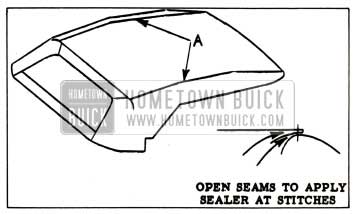
1957 Buick Convertible Top Sealing
Note that sealer is applied at two locations along each seam as indicated by two arrows.
- Position top trim on frame work and center assembly both fore and aft and side to side. Positively locate top by engaging the weather flaps at back curtain and by cementing the quarter flaps to side roof rails. See figure 13-116.
- Stay-tack top to the rear bow and align and stay-tack the seams on outer ends of rear bow. See figure 13-116.
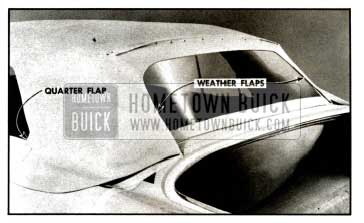
1957 Buick Installation of Weather Flaps and Quarter Flaps
- At front roof rail, pull top material forward (do not stretch excessively tight) and cement front flaps to the side roof rail. See figure 13-117.
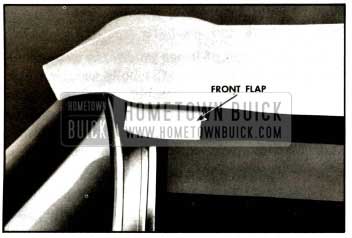
1957 Buick Cementing Front Flaps
- Remove outer trim stick screws and install 1957 Buick Convertible material into body. Trim stick screws beneath the back window must hold trim stick in position during following operation.
- Inside body draw down outer ends of back curtain and top material. When it has been determined that back curtain and top material are fitting properly together and to chrome belt molding, mark curtain and top as shown in figure 13-118 and install enough trim stick screws to maintain position.

1957 Buick Positioning Back Curtain
- At the front of body, draw top material forward across front roof rail which must be locked to windshield header. When most of fullness is removed, mark underside of top material opposite front edge of rail.
- Then, unlock roof rail and apply trim cement to lower side of rail and to top material which will contact this portion of rail. See figure 13-104.
- Align and cement the 1957 Buick Convertible material to the front roof rail, lock top and check fit of top material. Make any necessary alterations to the position of the top material at this time.
- Next unlock the top and tack the material to rail. See figure 13-104.
- Install front roof rail front weatherstrip and retainers and lock front roof rail.
- Recheck final marked position of back curtain outer ends and top material at rear trim stick. Draw top material to desired tension (not “drum” tight) and tack material to rear bow as shown in figure 13-119.
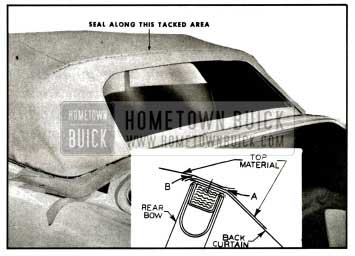
1957 Buick Sealing at Rear Bow
Trim off excess material. NOTE: The tacks outboard of seams should be restricted to a distance not to exceed six inches, which is the length wire on binding extends past seam.
IMPORTANT: This tacked joint must be sealed with an approved convertible top fabric sealer. Sealer should be applied from outside, as indicated at “A”, and from underside, as indicated at “B”. Sealer should be applied so that it will flow around tacks for proper seal.- Detach trim stick and tack outer ends of back curtain and top material to stick as shown in figure 13-120.
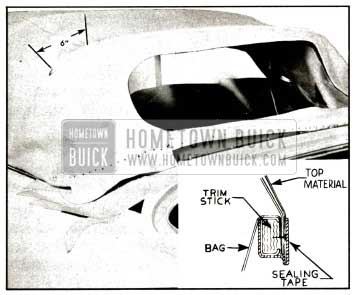
1957 Buick Top Attachment at Rear Trim Stick
Use marked line as locating reference.
IMPORTANT: Apply a waterproof sealing tape over tacked edges of back curtain and top material so that after back curtain and top material are trimmed, tape can be wrapped around to cover inside of trim stick. The inset in figure 13-120 shows final installation of seal ring tape after top installation has been checked and top material trimmed.- Install trim stick with all screws, and install wire-on binding and clip escutcheons.
- Inside of body, draw quarter section of top material to desired position with short trim stick held in place by hand. Then mark top material in same manner as was done at rear trim stick. See figure 13-120.
- Remove screws at end of rear trim stick to loosen top material in rear quarter area. Then place small trim stick in position along previous marking, roll stick to expose tacking surface, and tack top material to trim stick. NOTE: Make certain front inner guide attaching holes are at forward end of trim stick.
- Cut holes in top material to conform to holes in trim stick for front inner guide. Apply sealing tape to tacking surface of small trim stick.
- Position front inner guide on outboard edge of small trim stick and secure in place by two (2) nuts and washers. See figure 13-105.
- Insert end of inner guide into outer guide channel and install two (2) bolts securing trim stick and support assembly to rear quarter inner panel. Check alignment of top in quarter area and make any necessary adjustments. Install previously removed screws from end of large trim stick. See figure 13-105.
- When completed, folding top should be free of wrinkles and draws. Check operation and locking action of the top. Following this operation check, trim off excess material below trim sticks. CAUTION: Do not cut sealing tape during trimming operation.
- Wrap sealing tape around trimmed edges of top material and apply to inside of trim sticks. See figure 13-120.
- Install all previously removed trim and hardware and clean any soilage from top material, back curtain or pads.
Removal and Installation of External Top Only
To install the external top material only, remove the material without disturbing the back curtain or stay pads. Then reinstall the replacement top trim as outlined in the installation of the entire top starting with step 10.
Removal and Installation of Back Curtain Only
To install a replacement back curtain, it is necessary to detach the top material from the rear belt trim stick and from the rear bow. By making reference marks on the folding top trim and on the sealing tape along the belt molding, the top material can be returned to its original position with a minimum of refitting.
13-21 1957 BUICK HYDRO-LECTRIC SYSTEM (ALL SERIES CONVERTIBLES)
The 1957 Buick Convertible top Hydro-Lectric System is the same as used on past convertibles except for the installation of the motor and pump assembly. On past convertibles, the motor and pump unit was installed in a vertical position behind the left side of the rear seat back. On 1957 convertibles, the unit is installed in a horizontal position behind the center of the rear seat back.
Figure 13-121 shows an exploded view of the motor and pump assembly. The parts are indicated by letters.

1957 Buick Disassembling Motor and Pump Assembly
Removal of Motor and Pump Assembly
- Operate 1957 Buick Convertible top to full “up” position.
- Disconnect positive battery cable.
- Place protective covering over rear seat back and cushion.
- Working inside body, detach front edge of folding top compartment bag from rear seat back panel.
- Working on inside of body over the rear seat back, remove pump and motor shield attaching screws and remove shield.
- Remove clips securing the wire harness.
- Disconnect motor leads from the wire harness, and remove clips securing hydraulic hose to rear seat back panel.
- To facilitate removal apply a rubber lubricant to pump attaching grommets; then carefully disengage grommets from floor pan. See figure 13-122.
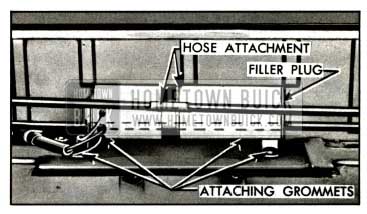
1957 Buick Motor and Pump Assembly Attachment
- Place absorbent rags below hose connections and end of reservoir.
- With a straight-bladed screw driver, vent reservoir by removing the filler plug; then reinstall plug.
NOTE: Venting reservoir is necessary in this “sealed-in” unit to equalize the air pressure in reservoir to that of atmosphere. This operation prevents possibility of hydraulic fluid being forced under pressure from disconnected lines and causing damage to trim or body finish.
- Disconnect hydraulic lines from sides of motor and pump assembly, and cap open fittings to prevent leakage of fluid. Use a cloth to absorb any leaking fluid, then remove unit from rear compartment.
Installation of Motor and Pump Assembly
- If a replacement unit is being installed, fill reservoir unit with specified Delco #11 hydraulic fluid (G. M. Hydraulic Brake Fluid Super #11). See “Checking Fluid in Reservoir” for proper fluid level.
- Connect hydraulic hoses, engage attaching grommets in panel and connect wiring.
- Remove reservoir filler plug and place absorbent rags under filler opening.
- Connect battery and operate top through its up and down cycle with filler plug removed from reservoir.
- Check connections for leaks and check fluid level in reservoir. See “Checking Fluid in Reservoir” for proper level.
- Install previously removed parts.
Disassembly of Reservoir Tube from Motor and Pump Assembly
- Remove motor and pump assembly from body.
- SCRIBE A LINE across the pump end plate, reservoir tube and reservoir tube end plate as shown in figure 13-123 to insure correct assembly of parts.
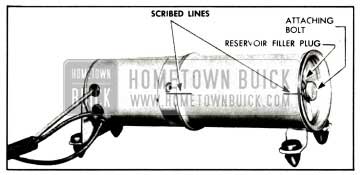
1957 Buick Motor and Pump Assembly
- With a straight-bladed screw driver, remove reservoir filler plug. Note sealing ring around plug.
- Drain fluid from reservoir into a clean container.
- With suitable tool remove bolt from end of assembly and remove reservoir end plate and tube. Note sealing rings around bolt, reservoir end plate, and between end of reservoir tube and pump assembly.
Assembly of Reservoir Tube to Motor and Pump Assembly
- Position sealing ring on pump and assemble reservoir tube to pump according to scribe marks.
NOTE: Bracket assembly on tube should be located at outer end when tube is assembled to pump.
- Position sealing ring on tube end plate and place end plate on reservoir tube, lining up the scribe marks. Install and tighten attaching bolt.
- Place unit in horizontal position and fill with fluid until level of fluid is even with bottom of filler plug hole.
- Make sure that sealing ring is on the filler plug, before installing filler plug.
Operation of the 1957 Buick Convertible Top
The principles of 1957 Buick Convertible top operation are the same as on previous models. When the control switch knob is pushed forward, the battery feed wire is connected to the red motor lead and the motor and pump assembly operate to force the hydraulic fluid through the hoses to the lower ends of the double-acting cylinders. The fluid forces the piston rods in the cylinders upward, thus raising the top. The fluid in the top of the cylinders returns to the pump for recirculation to the bottom of the cylinders. When the control switch knob is pulled rearward, the feed wire is connected to the dark green motor lead and the motor and pump assembly operate in a reversed direction to force the hydraulic fluid through the hoses to the top of the cylinders. The fluid forces the piston rods in the cylinders downward, thus lowering the top. The fluid in the bottom of the cylinders returns to the pump for recirculation to the top of the cylinders.
Operation of Pump Assembly
The rotor type pump assembly is designed to deliver a maximum pressure in the range of
240 psi to 280 psi. The operation of the pump assembly when raising the top is as follows:
- Raising the 1957 Buick Convertible Top. When the red motor lead is energized, the motor drive shaft turns the rotors clockwise as indicated by the large arrow in figure 13-124.
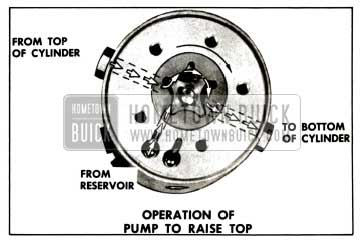
1957 Buick Raising Convertible Top
The action of the pump rotors forces the fluid under pressure to the bottom of each cylinder forcing the piston upward. This action causes the fluid above the piston in each cylinder to be forced into the pump, which recirculates the fluid to the bottom of the cylinders. The additional fluid required to fill the cylinder due to piston rod displacement is drawn from the reservoir as indicated.
- Lowering the 1957 Buick Convertible Top. When the green motor lead is energized the motor drive shaft turns the rotors counter-clockwise as indicated by the large arrow in figure 13-125.
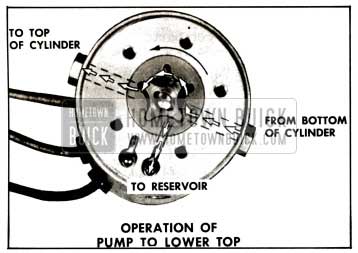
1957 Buick Lowering Convertible Top
The action of the pump rotors forces the fluid under pressure to the top of each cylinder. This action causes the fluid below the piston in each cylinder to be forced into the pump which recirculates the fluid to the top of each cylinder. The surplus hydraulic fluid due to piston rod displacement flows into the reservoir as shown.
Mechanical Checking Procedure
If there is a failure in the Hydro-Lectric system and the cause is not evident the mechanical operation of the top should first be checked. If the folding top assembly appears to have a binding action disconnect the top lift cylinder piston rods from the top linkage and then manually raise and lower the top. The top should travel through its up and down cycle without any evidence of a binding action. If a binding action is noted when the top is being locked at the header, check the alignment of the door windows ventilators and rear quarter windows with relation to the side roof rail weatherstrips. Make all necessary adjustments for correct top alignment. If a failure continues to exist after a check for mechanical failure has been completed the Hydro-Lectric system should then be checked for electrical or hydraulic failures.
Electrical Checking Procedure
If a failure in the Hydro-Lectric system continues to exist after the mechanical operation has been checked the electrical system should then be checked. A failure in the electrical system may be caused by a low battery, breaks in the wiring, faulty connections, mechanical failure of an electrical componeJ1t, or wires or components shorting to one another or to the body metal. Before beginning checking procedure, check battery according to procedure recommended in Buick Chassis Service Manual.
- Checking for Current at the Folding Top Control Switch
- Disengage terminal block from rear of switch.
- Connect light tester to central terminal of switch terminal block.
- Ground light tester ground lead to the body metal.
- If light tester does not light there is an open or short circuit between battery and switch.
- Checking the Folding Top Control Switch.
If there is current at the feed wire terminal of the terminal block the operation of the switch can be checked as follows:
- Place a #12 jumper wire on switch terminal block between center terminal (feed) and one of two motor wire terminals. If motor operates with jumper wire but did not operate with switch, the switch is defective.
- Connect jumper wire between center terminal (feed) and other motor wire terminal on switch terminal block. If motor operates with jumper wire, but did not operate with switch, the switch is defective.
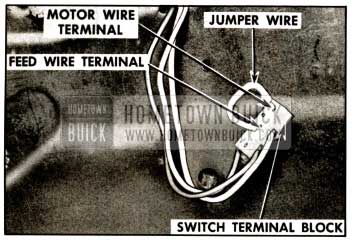
1957 Buick Checking Switch Terminal Block
- Checking Switch to Motor Lead Wires
If switch is found to be operating properly, the switch to motor lead wires can be checked as follows:
- Disconnect green switch-to-motor wire from motor lead in rear compartment.
- Connect a light tester to green switchto-motor wire terminal.
- Ground light tester ground lead to body metal.
- Pull switch control knob rearward. If tester does not light, there is an open or short circuit in wire.
- Disconnect red, switch-to-motor wire from motor lead.
- Connect light tester to red, switch-tomotor wire terminal.
- Push switch control knob forward. If tester does not light, there is an open or short circuit in wire.
- Checking the Motor Unit
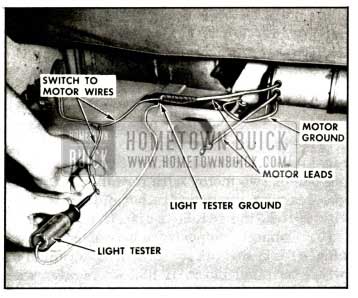
1957 Buick Checking Motor Lead Wires
If a light tester indicates current at the motor lead terminals of the switch to motor wires but the motor unit does not operate from the switch, a final check of the motor unit can be made as follows:
- Check connection of motor ground wire to body metal.
- Connect a #12 gauge jumper from battery positive pole to motor lead terminal that connects to green switch-to-motor wire. The motor should operate to lower top.
- Connect jumper wire to motor lead terminal that connects to red, switch-to-motor wire. The motor should operate to raise top.
- If motor fails to operate on either or both of these checks, it should be repaired or replaced.
- If motor operates with jumper wire but will not operate from switch-to-motor wires, the trouble may be caused by reduced current resulting from damaged wiring or poor connections.
Hydraulic Checking Procedure
Failures in the hydraulic system can be caused by lack of hydraulic fluid, leaks in hydraulic system, obstructions or kinks in hydraulic hoses or faulty operation of a cylinder or pump. A pressure gauge can be used to check the pressure of the pump. See “Checking the Pressure of the Pump.”
- Checking Hydraulic Fluid Level in Reservoir
- Operate 1957 Buick Convertible top to raised position.
- At the rear compartment, remove pump and motor shield.
- Place absorbent rags below reservoir at filler plug.
- With a straight-bladed screw driver, remove filler plug. Fluid level should be at the lower edge of filler plug hole.
- If fluid is low, add Delco #11 hydraulic fluid (G. M. Hydraulic Brake Fluid Super #11) to bring to specified level.
- Reinstall filler plug and pump and motor shield.
- Checking Operation of Lift Cylinders
- Remove rear seat cushion and folding top compartment side panel assembly.
- Operate folding top control switch and observe the lift cylinders during “up” and “down” cycles for these conditions:
- If movement of cylinder rods is not coordinated, or sluggish when the motor is actuated, check hydraulic hoses from motor and pump to cylinder for kinks.
- If one cylinder rod moves slower than the other, cylinder having slower moving rod is defective and should be replaced.
- If both cylinder rods move slowly or do not move at all, check the pressure of the pump. See “Checking the Pressure of the Pump.”
- Checking Pressure at the Pump
- Remove motor and pump assembly from rear compartment.
- Install plug in one port, and pressure gauge in port to be checked, as indicated in figure 13-128.
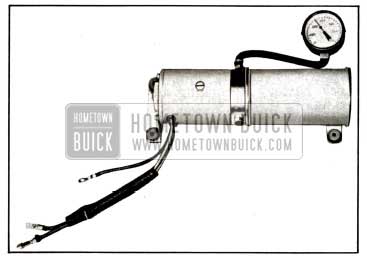
1957 Buick Checking Pump Pressure
- Actuate motor with an applied terminal voltage within range of 9.5 volts to 11.0 volts.
Pressure gauge should show a pressure between 240 psi. and 280 psi.- Check pressure in other port. NOTE: A difference in pressure readings may exist between the pressure port for top of cylinders and pressure port for bottom of cylinders. This condition is acceptable if both readings are within the limit of 240 psi. and 280 psi.
- If the pressure is not within specified limits, unit is defective and should be repaired or replaced, as required.
Removal of 1957 Buick Convertible Top Lift Cylinder
- Remove rear seat cushion and seat back.
- Remove 1957 Buick Convertible top compartment side trim panel.
- Remove attaching nut, bolt, bushing and washer from upper end of cylinder.
- Remove attaching screws from support at lower end of cylinder.
- Move cylinder to gain access to hydraulic hose connections.
- Disconnect and cap hydraulic connections on cylinder and on each hose.
CAUTION: Before disconnecting the hydraulic connections, place suitable wiping rags under the connections to absorb any drippage of hydraulic fluid. Also, disconnect the battery positive cable to prevent the accidental operation of the motor and pump while the hydraulic hoses are disconnected.
- Remove cotter pin, clevis pin, spacer and support from lower end of cylinder and remove cylinder.
- To install cylinder, reverse removal procedure with following exceptions: To aid in connection of cylinder piston rod to folding top linkage, use power to raise piston rod to extended position. Operate top down and up several times, then check and correct level of hydraulic fluid in reservoir.
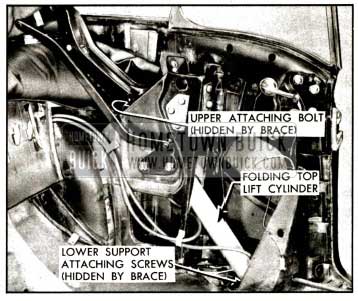
1957 Buick Folding Top Lift Cylinder Installation-Series 40-60

1957 Buick Folding Top Lift Cylinder Installation-Series 50-70

Leave A Comment
You must be logged in to post a comment.